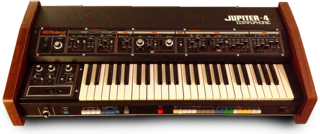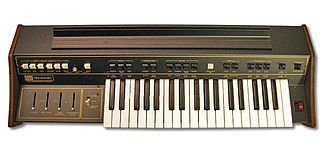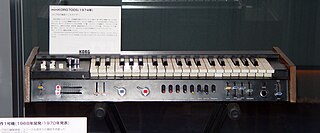
Casio Computer Co., Ltd. is a Japanese multinational electronics manufacturing corporation headquartered in Shibuya, Tokyo, Japan. Its products include calculators, mobile phones, digital cameras, electronic musical instruments, and analogue and digital watches. It was founded in 1946, and in 1957 introduced the first entirely compact electronic calculator. It was an early digital camera innovator, and during the 1980s and 1990s, the company developed numerous affordable home electronic keyboards for musicians along with introducing the first mass-produced digital watches.

An electronic keyboard, portable keyboard, or digital keyboard is an electronic musical instrument based on keyboard instruments. Electronic keyboards include synthesizers, digital pianos, stage pianos, electronic organs and digital audio workstations. In technical terms, an electronic keyboard is a rompler-based synthesizer with a low-wattage power amplifier and small loudspeakers.

Casiotone was a series of home electronic keyboards made by Casio in the early 1980s. Casio promoted the Casiotone 201 (CT-201) as "the first electronic keyboard with full-size keys that anyone could afford". The name "Casiotone" disappeared from Casio's keyboard catalog when more accurate synthesis technologies became prevalent, but the brand was reused for new models launched in 2019.

A sound module is an electronic musical instrument without a human-playable interface such as a piano-style musical keyboard. Sound modules have to be operated using an externally connected device, which is often a MIDI controller, of which the most common type is the musical keyboard. Another common way of controlling a sound module is through a sequencer, which is computer hardware or software designed to record and playback control information for sound-generating hardware. Connections between sound modules, controllers, and sequencers are generally made with MIDI, which is a standardized interface designed for this purpose.

The Realistic Concertmate MG-1 is an analog synthesizer manufactured by Moog Music in 1981 and sold by Radio Shack from 1982 to 1983 under their "Realistic" brand name. It was produced without some standard Moog features, such as pitch and modulation wheels, as a cost-cutting measure aimed at achieving a lower price for the consumer market. The synthesizer also featured a pair of pass-through RCA jacks, which allowed users to mix radio or records into the final live synthesized sound output.

The Roland Jupiter-4 (JP-4) was an analog synthesizer manufactured by the Roland Corporation between 1978 and 1981. It was notable as the company's first self-contained polyphonic synthesizer, and for employing digital control of analog circuits, allowing for such features as programmable memory, voice assignment modes, an arpeggiator, polyphonic portamento and others.

The Moog Liberation was one of the first commercially produced "keytar" synthesizers, released in 1980 by Moog Music. The instrument is comparable to the Moog Concertmate MG-1 and the Moog Rogue, but it is most closely related to the Moog Prodigy; however, as a keytar, the Liberation was designed to be played in the same posture as one would play a guitar.

The ARP Pro Soloist was one of the first commercially successful preset synthesizers. Introduced by ARP Instruments, Inc. in 1972, it replaced the similar ARP Soloist (1970–1971) in the company's lineup of portable performance instruments.
The term lead instrument carries a variety of connotations. A lead instrument could be a reference to an instrument that plays the melody of a piece, an instrument that has been designed for this purpose, such as clarinet or violin, or a specific member of an orchestra that is featured as the most proficient musician of the group. In the digital music composition, lead may refer to the tone quality that is applied to a signal.

The Moog Source is a monophonic Z80 microprocessor-controlled analog synthesizer manufactured by Moog Music from 1981 to 1985. The Source was Moog's first synthesizer to offer patch memory storage. The design was also the first Moog synthesizer to feature a flat-panel membrane keyboard to replace the standard buttons, knobs and sliders, along with multihued panel graphics that were very different from anything Moog offered at the time. Sound wise it is considered to sound more like the original Moog Minimoog than any other synthesizer made by Moog and was introduced as its replacement.

The Roland JD-800 is a digital synthesizer that was manufactured between 1991 and 1996. It features many knobs and sliders for patch editing and performance control — features that some manufacturers, including Roland, had been omitting in the name of streamlining since the inception of the Yamaha DX7. The JD-800 thus became very popular with musicians who wished to take a hands-on approach to patch programming. The introduction in the manual states that Roland's intention with the JD-800 was to "return to the roots of synthesis".

The ARP Omni was a polyphonic analog synthesizer manufactured by ARP Instruments, Inc.

A synthesizer is an electronic musical instrument that generates audio signals. Synthesizers typically create sounds by generating waveforms through methods including subtractive synthesis, additive synthesis and frequency modulation synthesis. These sounds may be altered by components such as filters, which cut or boost frequencies; envelopes, which control articulation, or how notes begin and end; and low-frequency oscillators, which modulate parameters such as pitch, volume, or filter characteristics affecting timbre. Synthesizers are typically played with keyboards or controlled by sequencers, software or other instruments and may be synchronized to other equipment via MIDI.

The Evolver is an analog-digital hybrid synthesizer designed by Dave Smith and manufactured by Dave Smith Instruments. It was first released as a desktop version in 2002, then later a 37-key keyboard bearing the same synth engine as the Evolver desktop was also released. A polyphonic version of the Evolver, dubbed the Poly Evolver, was released in 2004 as a rackmount version, then a 61-key keyboard version of the Poly Evolver was released in 2005. The Evolvers were replaced by new high end models, the Prophet 12 and the Pro 2.
Casio's SDSynthesizers were a late-1980s line of analog synthesizers featuring a resonant filter. SD synthesis was traditional DCO-analog synthesis, with the main difference being that some of the SD waveforms' harmonic spectrums changed temporally, or dynamically in relation to the amplitude envelope.
The Casio Casiotone MT-40 is an electronic keyboard, formerly produced by Casio and originally developed for the consumer market. It was released in 1981, with the MT-41 gray version releasing in 1983.

The Sirius is a keyboard "groove-synth," featuring a subtractive hybrid-tone-generation synthesizer referred to as DTE synthesis introduced in 1997 by Quasimidi. The unit featured both real-time and step sequencers with pattern- and song-modes, capable of acting basic drum machine, groove-box, or sound-module.

The Split-8 is a polyphonic analogue keyboard synthesizer manufactured by Sequential Circuits. Built in Japan and going by the alternative name Pro-8 in some markets, this was one of the last synthesizers produced by the company and was assigned model number 608. It was released in 1985 at a list price of $1,199. This and some other Sequential Circuits synthesizers were built around the Curtis Electronics CEM 3394 "synth-on-a-chip" integrated circuit, and used a Z80 as their central microprocessor.

The CZ series is a family of low-cost phase distortion synthesizers produced by Casio in the mid-1980s. Eight models of CZ synthesizers were released: the CZ-101, CZ-230S, CZ-1000, CZ-2000S, CZ-2600S, CZ-3000, CZ-5000, and the CZ-1. Additionally, the home-keyboard model CT-6500 used 48 phase distortion presets from the CZ line. The CZ synthesizers' price at the time of their introduction made programmable synthesizers affordable enough to be purchased by garage bands. Yamaha soon introduced their own low-cost digital synthesizers, including the DX-21 (1985) and Yamaha DX100, in light of the CZ series' success.

The miniKORG 700 is a monophonic analog synthesizer released by Korg in 1973, marking their entry into mass-produced synthesizers and their first monophonic synthesizer. It was initially designed to be placed on top of an organ, so its controls are located below the keyboard facing towards the performer. An updated model, the miniKORG 700S, was launched in 1974, introducing a second oscillator that could be detuned, along with additional sustain and vibrato controls.



















